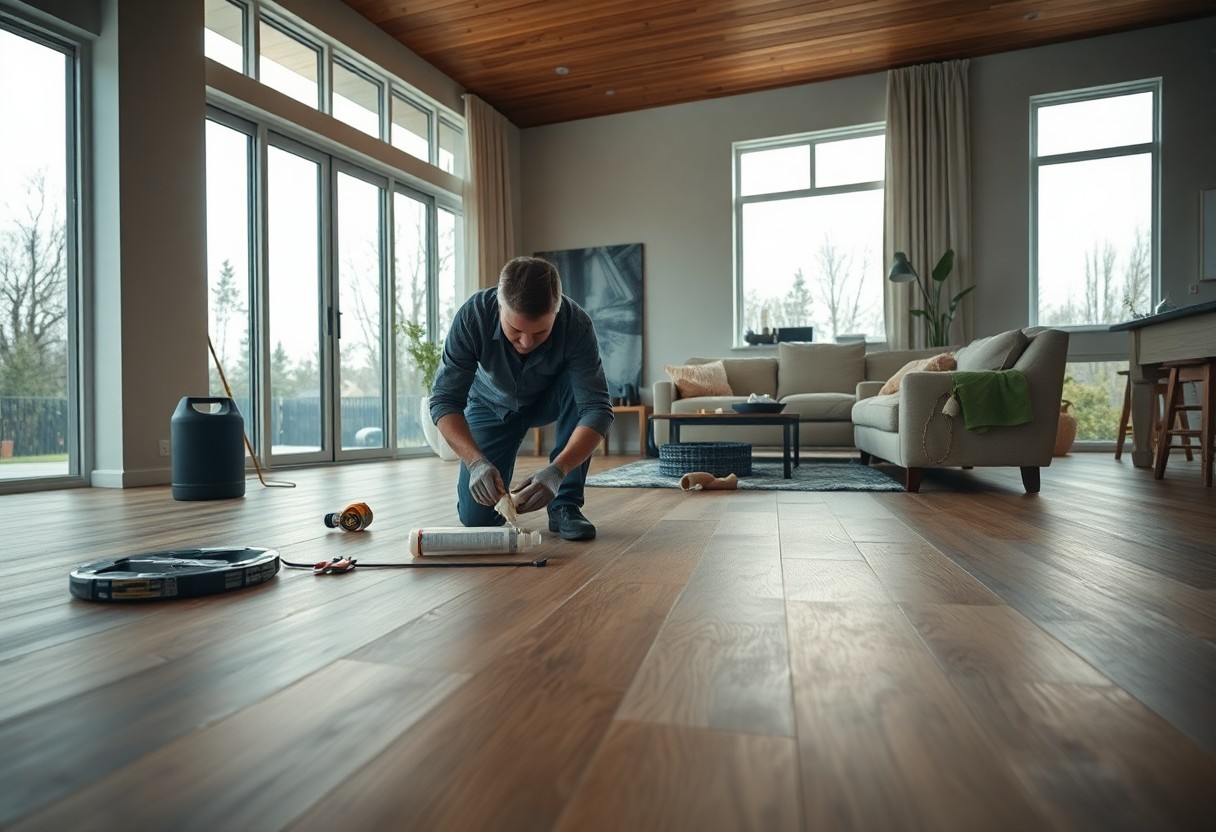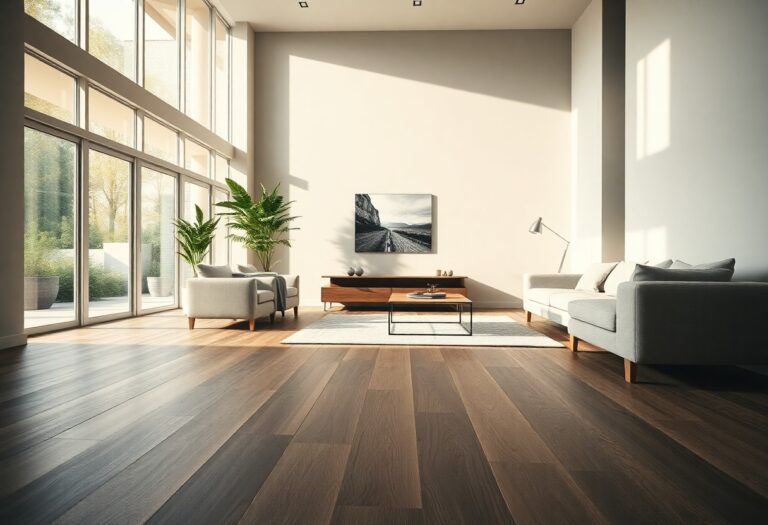Maintenance is an necessary aspect to consider when choosing flooring, and dry back vinyl flooring offers numerous advantages that make it an ideal choice for your home. This guide will provide you with detailed insights into the benefits of dry back vinyl, tips for proper installation, and straightforward maintenance procedures. With its durability and aesthetic appeal, you can transform your space while ensuring a long-lasting floor that meets your lifestyle needs.
Understanding Dry Back Vinyl Flooring
Dry back vinyl flooring is a type of resilient flooring that features a glue-down installation method. This flooring solution adheres directly to the subfloor, providing a stable and durable surface for high-traffic areas in both residential and commercial settings. By understanding its components, benefits, and installation process, you can make an informed decision that suits your needs.
What is Dry Back Vinyl Flooring?
Dry back vinyl flooring is constructed from multiple layers, including a backing layer, core, design layer, and wear layer. Unlike click-lock vinyl options, dry back requires adhesive for installation, which allows it to lay flat and directly bond to the subfloor. This creates a seamless appearance and low-maintenance surface.
Key Features and Characteristics
Dry back vinyl flooring is known for its durability, affordability, and ease of maintenance. It mimics the appearance of natural materials, such as wood and stone, making it a popular choice for various design styles. Key features include:
- Durable and long-lasting
- Water resistant, suitable for wet areas
- Easy to clean and maintain
- Variety of design options
- Comfortable underfoot
In addition to these features, dry back vinyl flooring’s installation flexibility caters to diverse environments. Its stable structure can withstand temperature changes, reducing the risk of warping or damage. Moreover, because it is installed with adhesive, it minimizes movement and shifting, ensuring a longer lifespan. The wide range of designs also means you can find options that suit your specific aesthetic preferences.
- Stable and secure when installed properly
- Compatible with floor heating systems
- Cost-effective solution compared to hardwood or tile
- Low VOC emissions, improving indoor air quality
- Backed by various warranties for peace of mind
Dry back vinyl flooring stands out due to its ability to replicate high-end looks without the associated costs. You have the freedom to choose from patterns that resemble traditional hardwood or sleek modern tiles, allowing you to create your desired ambiance in any space. Its installation and maintenance simplicity make it a favorite for both DIY enthusiasts and professional installers alike.
Benefits of Dry Back Vinyl Flooring
Choosing dry back vinyl flooring comes with a multitude of benefits, primarily its combination of durability, design flexibility, and affordability. This flooring solution meets various lifestyle needs, providing a robust surface that withstands wear and tear while being stylish enough to complement any décor. Its ease of installation and maintenance further enhances the appeal, making it a top choice for both residential and commercial spaces.
Durability and Longevity
Dry back vinyl flooring is known for its exceptional durability, which makes it resistant to scratches, dents, and general wear. With a wear layer typically ranging from 12 to 20 mils, you can expect it to last anywhere from 10 to 20 years, depending on the quality and maintenance. This resilience is particularly beneficial in high-traffic areas, ensuring that your flooring continues to look new even with daily use.
Design Versatility
One of the standout features of dry back vinyl flooring is its design versatility. You can find a wide array of styles, colors, and textures that mimic the look of natural materials like hardwood, stone, or tile, allowing you to customize your space without sacrificing aesthetic appeal. With options ranging from sleek, modern designs to rustic finishes, you can easily find something that fits your personal style and enhances your interior décor.
This design adaptability extends to various formats, including planks, tiles, or sheets, giving you the freedom to create unique patterns and layouts. Whether you prefer a contemporary look with large tiles or a traditional feel with planks, dry back vinyl enables you to achieve your desired aesthetic. Plus, the ability to coordinate with furniture and other design elements makes it a practical choice for those looking to make a cohesive style statement in their homes or offices.
Cost-Effectiveness
Dry back vinyl flooring offers an attractive price point without compromising on quality, making it a cost-effective flooring option. With installation costs typically lower than traditional flooring materials, you can save money upfront while benefiting from its long lifespan. This balance between affordability and durability makes it a smart investment for homeowners and businesses alike.
The overall value is enhanced by the low maintenance requirements of dry back vinyl flooring; no need for expensive cleaners or extensive upkeep, further reducing long-term costs. In fact, many options come with warranties of up to 20 years, showcasing the confidence manufacturers have in their durability. With energy-efficient options available as well, you’ll find that dry back vinyl not only looks good but also saves you money in your budget over time.
Installation Process
The installation process for dry back vinyl flooring is straightforward, allowing homeowners to transform their spaces with ease. Proper preparation and the right tools are important for achieving a professional finish, whether you are a seasoned DIYer or a first-time installer.
Preparation and Tools Needed
Before starting, ensure your subfloor is clean, dry, and level. Gather important tools, including a utility knife, straight edge, adhesive, trowel, measuring tape, and a roller for securing the flooring. Having these items ready will streamline your installation process and contribute to a successful outcome.
Step-by-Step Installation Guide
Begin by measuring the area to determine how much flooring you’ll need, then acclimate the vinyl planks to the room’s temperature and humidity for at least 48 hours. Apply the adhesive evenly with the trowel, lay your first plank, and use a roller to eliminate air bubbles. Continue laying planks edge to edge, cutting pieces as necessary for a snug fit.
Step-by-Step Installation Guide
| Step | Action |
|---|---|
| 1 | Measure the installation area for material requirements. |
| 2 | Allow vinyl planks to acclimate. |
| 3 | Apply adhesive on the subfloor using a trowel. |
| 4 | Lay the first plank and use a roller to secure. |
| 5 | Continue positioning planks and trim as needed. |
This guide ensures that you follow each step methodically, promoting strong adhesion and a smooth finish. Each plank should fit tightly against the previous one, and it’s important to check for misalignments throughout the process to guarantee a flawless appearance. When complete, allow the flooring to cure as per the adhesive manufacturer’s recommendations before heavy use.
Complete Installation Summary
| Focus Area | Key Insights |
|---|---|
| Measurement | Ensure accurate measurements to avoid material waste. |
| Acclimation | Allow time for planks to adjust to room conditions for optimal performance. |
| Adhesive Application | Use consistent pressure and an even layer for the best bond. |
| Final Touches | Check alignment before the adhesive sets for a tidy finish. |
Maintenance Tips
To ensure the longevity of your dry back vinyl flooring, regular maintenance is key. By following simple care practices, you can keep your floors looking new longer. Here are some imperative tips:
- Sweep or vacuum regularly to remove dirt and debris.
- Use a damp mop with a gentle cleaner for deeper cleaning.
- Avoid harsh chemicals that can damage the surface.
- Place mats at entrances to minimize grit and moisture.
- Address spills immediately to prevent staining.
Perceiving these small steps as routine will contribute significantly to the lifespan of your flooring.
Cleaning and Care
Cleaning dry back vinyl flooring is simple; you just need to use the right products and techniques. Regular sweeping or vacuuming will help eliminate dust and dirt. For a deeper clean, a damp mop paired with a pH-neutral cleaner is effective. Avoid soaking the flooring, as excess water can seep into seams and cause damage. By maintaining a consistent cleaning routine, you protect your investment and keep the floors shiny and attractive.
Common Mistakes to Avoid
Avoiding specific pitfalls can save you time and maintain your flooring’s appearance. Some common mistakes include using abrasive cleaners that can scratch the surface and neglecting to address spills promptly, which can lead to stains. Additionally, failing to use furniture pads can result in unsightly scratches and dents over time. Being mindful of these issues will help you preserve the quality of your flooring for years to come.
Not only should you prioritize cleaning with suitable products, but you should also be cautious when moving heavy furniture; dragging items can cause irreversible damage. Failing to implement preventive measures like mats at entryways can lead to dirt accumulation, compounding cleaning efforts. Lastly, neglecting to schedule periodic inspections can allow minor issues to develop into larger problems, potentially incurring high repair costs. By recognizing and avoiding these mistakes, you ensure your dry back vinyl flooring remains in optimal condition.

Comparing Dry Back with Other Flooring Options
| Flooring Type | Comparison |
|---|---|
| Dry Back Vinyl | Highly durable and stable, requires glue for installation, suitable for various environments. |
| Peel and Stick | Easy to install, less durable, best for low-traffic areas. |
| Luxury Vinyl Tile (LVT) | Offers similar aesthetics to hardwood or stone, realistic texture, and can be self-adhesive or dry back. |
Dry Back vs. Peel and Stick
When comparing dry back vinyl to peel and stick options, dry back presents a stronger bond due to its adhesive installation process. This makes it more suitable for high-traffic areas, while peel and stick might become loose over time. Additionally, dry back installations typically yield a more seamless and professional appearance, enhancing the overall aesthetic of your space.
Dry Back vs. Luxury Vinyl Tile (LVT)
In the battle of dry back and luxury vinyl tile, both share qualities like resilience and water resistance. However, LVT can offer a wider range of designs and textures, mimicking authentic wood or stone surfaces. While LVT may be available in both click-lock and dry back formats, the latter generally provides superior stability against temperature and humidity fluctuations.
Dry back vinyl flooring stands out in terms of stability and longevity, making it ideal for spaces where performance is key. While luxury vinyl tile impresses with its style and visual appeal, dry back flooring maintains a more robust structure due to its installation method. Your choice may depend on aesthetic desires versus practical needs, but dry back’s durability will often give it the edge in high-usage areas.
Frequently Asked Questions
This section addresses common queries regarding dry back vinyl flooring, its features, and how to effectively maintain it. You may find answers to installation concerns, maintenance tips, and information about longevity here, helping you make informed decisions for your flooring needs.
Common Concerns
Many homeowners worry about the potential for vinyl flooring to dent or scratch, particularly in high-traffic areas. However, dry back vinyl’s robust construction offers impressive resistance against wear and tear, making it a smart choice for busy households and commercial spaces alike.
Troubleshooting Issues
Having trouble with your dry back vinyl flooring? Issues such as buckling, adhesive failure, or seams lifting can arise. Identifying the root cause is key; it often relates to improper installation, humidity levels, or using unsuitable cleaning products.
If your flooring has developed bumps or seems to be lifting, check for moisture under the surface, as excess humidity can weaken the adhesive. For seams that are separating, inspect for manufacturer defects or improper fitting during installation. Additionally, make sure you’re using non-abrasive cleaners to maintain the integrity of the vinyl. Proper temperature regulation and cleaning routines will help in preventing these common problems, ensuring longevity and aesthetic appeal for your floors.
Final Words
Taking this into account, dry back vinyl flooring presents an excellent choice for your home, offering durability, aesthetic appeal, and ease of maintenance. Understanding its benefits, straightforward installation process, and proper care will empower you to make informed decisions that enhance your living space. By choosing this flooring option, you ensure a stylish and practical solution that fits your lifestyle needs while providing a comfortable and resilient surface for years to come.





